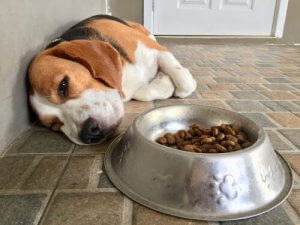4 Main Causes of Colitis in Dogs


Written and verified by biochemistry Luz Eduviges Thomas-Romero
Colitis in dogs is the irritation of the colon and is quite a common condition. It’s not really a disease in itself, but rather a symptom of several other possible medical problems.
The word ‘colitis’ literally means ‘inflammation of the colon’. The colon is the last section of the intestines and is responsible for the final stages of digestion.
What is colitis in dogs?
When the lining of the colon gets irritated and inflamed, this disrupts the digestion process. As a result, mediators are produced that increase inflammation and affect the integrity of the intestinal wall.
In other words, the barrier which separates the contents of the intestines from the bloodstream deteriorates and ulcerations appear. At the same time, this inflammation triggers the secretion of mucus and other substances from the colon lining that interfere with movement through the intestines.
At the cell level, the colon is less able to absorb water from waste products and store and move feces. This makes feces more loose, watery, fatty, and can sometimes contain mucus or fresh blood.

Sadly, animals with colitis can’t exactly tell us how they feel, but the disease is very similar to that suffered by humans. As a result, we assume that a dog suffering from colitis is in quite a lot of discomfort and pain.
Main causes of colitis in dogs
1. Changes in the microbiota or intestinal dysbiosis
The ‘intestinal microbiota‘ is the name for all microorganisms (bacteria, fungi, protozoa, and viruses) living in the gastrointestinal tract. Bacteria are the most numerous microbes in the intestines.
Whilst these are often called ‘microflora’ in literature, the appropriate term is ‘microbiota’. This derives from the Greek ‘bio’, which means ‘life’. There’s a huge diversity of different species of bacteria in the intestines, where they live and establish their own ecosystem. When someone is healthy, this ecosystem is in total balance.
It’s estimated that there are billions of bacteria cells in the colon. This is around 10 times more cells than in a dog’s entire body, so it’s clearly significant.
A change in the usual balance or make up of the microbiota is called intestinal dysbiosis. There are a number of factors that can cause this, such as antibiotic medications, a poor diet, or stress.
Studies in both people and dogs have linked intestinal dysbiosis with a number of gastrointestinal problems including inflammatory bowel, Crohn’s disease, and irritable bowel syndrome.
Although it’s not always clear whether dysbiosis is a cause or effect of gastrointestinal disease, we do know that restoring the balance of the microbiota can greatly aid treatment.
2. Stress
Stress is a significant cause of colitis, especially for dogs in an animal shelter. Traveling and moving can cause stress, but each dog will have its own problems which could lead to colitis.
3. Infection or parasites
E. coli, Salmonella, Giardia worms, and infections by bacteria or intestinal parasites can all cause colitis. Dogs can become infected by eating contaminated food or water or even through contact with other dogs.
When you go out on longer walks, remember to take some water and possibly a bowl. This will reduce your dog’s temptation to drink from puddles. Even if it looks clean, it can still be contaminated.
4. Allergies
Dogs can be allergic to the same things as people, whether it be food, household items, or things in our environment. Just like with people, allergies in dogs can be difficult to diagnose.
The breed is a factor
We currently already know that genetics can be a key factor in inflammatory bowel diseases. Boxer dogs are particularly prone to histiocytic ulcerative colitis, whilst German shepherds have a higher incidence rate of lymphocytic-plasmacytic enterocolitis.

Furthermore, irritable bowel syndrome, which is a common cause of colitis in dogs, is also common in pets. Pets that eat indiscriminately or animals that spend a lot of time alone outdoors are also at increased risk of colitis.
As you can see, although it can be serious, it’s still possible to prevent or reduce the risk factors associated with colitis in dogs. The key thing is to be fully informed and to take any necessary precautions.
Colitis in dogs is the irritation of the colon and is quite a common condition. It’s not really a disease in itself, but rather a symptom of several other possible medical problems.
The word ‘colitis’ literally means ‘inflammation of the colon’. The colon is the last section of the intestines and is responsible for the final stages of digestion.
What is colitis in dogs?
When the lining of the colon gets irritated and inflamed, this disrupts the digestion process. As a result, mediators are produced that increase inflammation and affect the integrity of the intestinal wall.
In other words, the barrier which separates the contents of the intestines from the bloodstream deteriorates and ulcerations appear. At the same time, this inflammation triggers the secretion of mucus and other substances from the colon lining that interfere with movement through the intestines.
At the cell level, the colon is less able to absorb water from waste products and store and move feces. This makes feces more loose, watery, fatty, and can sometimes contain mucus or fresh blood.

Sadly, animals with colitis can’t exactly tell us how they feel, but the disease is very similar to that suffered by humans. As a result, we assume that a dog suffering from colitis is in quite a lot of discomfort and pain.
Main causes of colitis in dogs
1. Changes in the microbiota or intestinal dysbiosis
The ‘intestinal microbiota‘ is the name for all microorganisms (bacteria, fungi, protozoa, and viruses) living in the gastrointestinal tract. Bacteria are the most numerous microbes in the intestines.
Whilst these are often called ‘microflora’ in literature, the appropriate term is ‘microbiota’. This derives from the Greek ‘bio’, which means ‘life’. There’s a huge diversity of different species of bacteria in the intestines, where they live and establish their own ecosystem. When someone is healthy, this ecosystem is in total balance.
It’s estimated that there are billions of bacteria cells in the colon. This is around 10 times more cells than in a dog’s entire body, so it’s clearly significant.
A change in the usual balance or make up of the microbiota is called intestinal dysbiosis. There are a number of factors that can cause this, such as antibiotic medications, a poor diet, or stress.
Studies in both people and dogs have linked intestinal dysbiosis with a number of gastrointestinal problems including inflammatory bowel, Crohn’s disease, and irritable bowel syndrome.
Although it’s not always clear whether dysbiosis is a cause or effect of gastrointestinal disease, we do know that restoring the balance of the microbiota can greatly aid treatment.
2. Stress
Stress is a significant cause of colitis, especially for dogs in an animal shelter. Traveling and moving can cause stress, but each dog will have its own problems which could lead to colitis.
3. Infection or parasites
E. coli, Salmonella, Giardia worms, and infections by bacteria or intestinal parasites can all cause colitis. Dogs can become infected by eating contaminated food or water or even through contact with other dogs.
When you go out on longer walks, remember to take some water and possibly a bowl. This will reduce your dog’s temptation to drink from puddles. Even if it looks clean, it can still be contaminated.
4. Allergies
Dogs can be allergic to the same things as people, whether it be food, household items, or things in our environment. Just like with people, allergies in dogs can be difficult to diagnose.
The breed is a factor
We currently already know that genetics can be a key factor in inflammatory bowel diseases. Boxer dogs are particularly prone to histiocytic ulcerative colitis, whilst German shepherds have a higher incidence rate of lymphocytic-plasmacytic enterocolitis.

Furthermore, irritable bowel syndrome, which is a common cause of colitis in dogs, is also common in pets. Pets that eat indiscriminately or animals that spend a lot of time alone outdoors are also at increased risk of colitis.
As you can see, although it can be serious, it’s still possible to prevent or reduce the risk factors associated with colitis in dogs. The key thing is to be fully informed and to take any necessary precautions.
All cited sources were thoroughly reviewed by our team to ensure their quality, reliability, currency, and validity. The bibliography of this article was considered reliable and of academic or scientific accuracy.
- Bush, B. (1995). Colitis in the dog. In Practice, 17(9), 410-417.
- Suchodolski, J. S. (2016). Diagnosis and interpretation of intestinal dysbiosis in dogs and cats. The Veterinary Journal, 215, 30-37.
- Ackerman, N. (2017). The canine microbiome. The Veterinary Nurse, 8(1), 12-16.
- Bhagat, R., Sheikh, A. A., Wazir, V. S., Mishra, A., & Maibam, U. (2017). Food allergy in canines: A review. Journal of Entomology and Zoology Studies, 5(6), 1522-1525.
- Heilmann, R. M., & Allenspach, K. (2017). Pattern-recognition receptors: signaling pathways and dysregulation in canine chronic enteropathies—brief review. Journal of Veterinary Diagnostic Investigation, 29(6), 781-787.
This text is provided for informational purposes only and does not replace consultation with a professional. If in doubt, consult your specialist.








